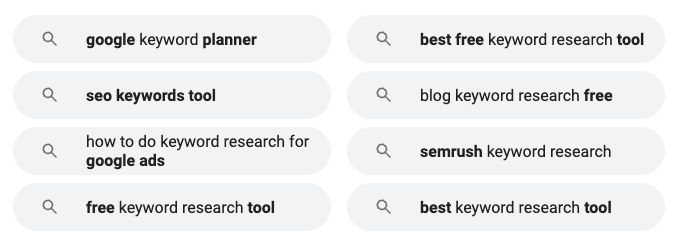TL;DR: You need to optimize your blog posts (and other website pages) if you want to be found. This requires carrying out initial keyword research and reviewing your posts (and pages) for optimization on a semi-regular basis.
- How to do keyword research for a blog post
- Focusing in on your keywords
- Optimizing published posts
- Moving beyond keywords
Your expertise is a key selling point. After all, if potential customers trust you, then they’re far more likely to make a purchase. This is one of the main roles that your blog plays in your marketing strategy. By posting free content that provides specific, valuable advice, you’re setting yourself up as an expert and boosting trust.
The issue is your expertise alone isn’t going to be enough for people to find you. You could be posting the greatest content in the world but, unless you follow SEO best practices, nobody is going to know where you are.
It all comes down to the keywords you use. Yes, you should be including keywords in the initial writing, but it’s also important to occasionally review your posts to identify what your target audience is searching for and optimize for that.

How to do keyword research for a blog post
It’s always possible to go back and optimize a post for keywords, but that doesn’t mean you can ignore them at the beginning of the process.
Carrying out initial keyword research not only helps you to get a head start in climbing the search engine rankings, but it can also shape the topics you write about in the first place. If you see a pattern of common problems potential customers are having, you can begin developing content that addresses these issues.
What’s more, there are literally unlimited opportunities out there to carve a space for yourself on the internet. Studies show that 15% of keywords in a given year have never been used before.
There are different approaches you can take to carry out this initial research.
Google keywords as if you were a customer
The first and simplest way to begin the process is by putting yourself in your customers’ shoes and searching as if you are in need of your own service. It requires a little bit of imagination but you’ll soon be able to see what comes up and get inspiration from it. Write down any keywords or phrases that you find.
It is worth noting, however, that your expertise may get in your way here. If you work in a particular field day in, day out, your concept of what’s basic knowledge gets skewed. A website developer may never comprehend that someone doesn’t know what WordPress is, for example. Yet there are many out there who have no idea and need to do very basic research on the topic.
The point is, Google searches aren’t enough to gain in-depth keyword research tips or insights and there are going to be blind spots.
What your competitors are doing
One of the ways to begin filling in these blind spots is by seeing what your competitors are doing. Standing out in SERP results is difficult and an incredible 90% of content on the internet doesn’t appear in any rankings. This means there’s plenty to learn from the companies that do appear.
When searching on Google, you’ll quickly find the stand-out companies that keep coming up in results. Go onto their website and have a close look at their blog posts and pages.
Ask yourself:
- How have they divided up the content?
- Are there any topics you hadn’t considered?
- How long are their posts?
- What do they feature on the front page of their blog? (If it isn’t just the most recent.)
Do this on a couple blogs and you’ll get an idea of what are popular topics, trends, and keywords in the industry.
Using tools
Finally, you can use tools to really flesh out your initial keyword research. Unlike the other approaches, this will be based on more measurable metrics such as search volume, competition, and specific combinations of words and phrases.
There are many tools available if you just want to carry out keyword research. Most of them have free versions, but they are generally quite limited. It might be that you can only search for a certain number a day or they hide part of the information.
Some of the most popular keyword research tools are:
- Answer the public. You enter a few topic words and this SEO keywords tool will give you questions that are asked. It’s very visual and provides good insights, but the free version is quite limited.
- Semrush. A powerful tool with a seven day trial period.
- Google Ads. Get insights right from the source! Google’s Keyword Planner is an excellent tool available to anyone running paid campaigns.
- DIY SEO Management Platform. Our platform puts you in control of your SEO and includes powerful keyword research capabilities.

Focusing in on your keywords
If you’ve carried out all the research above, you may find you’re overwhelmed by all the information you have. So the next step is narrowing down your list to find the keywords that are most relevant to you and have the most potential for success.
The trick is to find keywords that have the highest search volume with the lowest competition. If it’s a high search volume but high competition, it’s going to be very difficult to get your content above the hundreds of other websites that are also trying for that keyword. If it’s low search volume and low competition, it may be easy to make the top ten on Google, but nobody is searching for you.
For each blog post, you want to have a unique focus keyword. When writing your blog post on WordPress, you’ll be able to put in your focus keyword and see how well your post is optimized. Yoast used to be the plugin of choice to do this, but we now recommend SEOPress after Yoast was acquired by Newfold Digital.
Once you’ve picked your focus keyword, it’s a matter of including the Latent Semantic Indexing (LSI) keywords, which are related to your focus keyword. This is quite simple to do. Simply search for your focus keyword on Google and at the bottom of the page, you’ll see suggestions. These are your LSI.
For the focus keyword, “How to do keyword research for a blog post,” the LSI are:

Tips for including keywords in your blog post
How many keywords should I include in my blog post? Where should I include them? Can I put too many in? These are the eternal questions SEO blog writers ask. And the reason they are eternal is because the answers change over time. Ten years ago, the trend was to write 500-word posts, repeating your one-word keyword as many times as possible. If you do that now, you’ll either get penalized by Google or ignored completely—which is essentially the same thing.
That said, here are the current best practices:
- Use 1–2 long-tail keywords.
- Use the keyword no more than five times.
- Include the keyword in a H2 or H3 tag if natural.
- Include the keyword or LSI in the image alt tag if natural.
- Optimize the meta description.

Optimizing published posts
Publishing a blog post alone is not enough. In fact, 66.6% of all clicks go to the top five posts in search results. So, if you’re not at least in the top 10, you’re unlikely to get many visitors.
It could be that you published a post without giving much consideration to keywords in the first place or that the keywords aren’t performing as you thought they would. Either way, you also need to review them to see how they’re performing and identify opportunities for improvement.
While there are many tools that you could use to help you with this, the two that are indispensable are:
Both of these tools are provided by Google and give real-time insights and overviews of ongoing trends regarding the performance of your website.
Google Analytics is a particularly powerful tool for website optimization, but when talking specifically about how your keywords are performing, Search Console is your best friend. In this post, we’re only going to focus on Search Console but Analytics will also give you key insights.
In Search Console, there are two key areas to look out for.
Check how keywords are performing
Firstly, you need to see how your keywords are performing. When signed into Search Console, go to the “Performance” tab then click “Pages.” This will show you the pages where you’re appearing in search results.
Many of the pages will be from your website home page, etc., but scroll down until you find a blog post. Once you find one, click on it.
Now, you’ll have insights into that particular post. It will give you an overview of your current average position on Google, the Click Through Rate and other key metrics. But if you scroll down below the graph, you’ll see a tab called “Queries.” This is the keyword goldmine.
Here, you’ll see the keywords people are searching for when your post appears. Take a moment to compare the reality with what you’ve currently optimized your post for. Are they the same? If not, it may be worth optimizing the post with the most popular keywords that appear.
Now, this comes with a small warning. Just because your post is showing up for particular keywords does not necessarily mean that you should optimize for that keyword. Always remember the importance of intent. Ask yourself, why are people searching for that keyword and does my post answer that query?
If you believe it does, then optimize the post for the keywords that are appearing and check again in a month or two to see if there’s any change.
Repeat the process with all of your blog posts and pages.
Look for new keyword opportunities
Search Console can also give you keyword ideas that you hadn’t considered before or didn’t come up in your original research.
To find them, click on the “Performance” tab and you’ll see an overview of your site’s entire data. As with the individual pages, you’ll be able to see the queries people are searching for that are relevant to your website.
The difference is this is for your website as a whole and not just specific pages. When looking through the queries, try to find ones that have high impressions. Again, take a moment to think about the intent of each keyword to truly understand why people are searching for those terms.
Make a list of the most promising ones. Next, go through your backlog of posts and see if there are any where the keywords could fit. If the intent lines up, try optimizing the posts with the new keywords.
If none of your current blog posts really work with the high-impression keywords, consider using them as a basis to create new posts. After all, it’s what your potential customers are searching for!
Moving beyond keywords
We could argue that keywords are the most important part of getting your posts to the top of Google. But they are definitely not the only factor at play.
It’s like the quarterback on a football team. They play a fundamental role in winning games, but you still need an entire squad, each performing different roles, to have a chance. If the other parts of your SEO strategy aren’t in place, it doesn’t matter how good your keywords are.
Our DIY SEO Management Software puts you in control of your SEO with simple, easy-to-follow actions that improve your search visibility each month. Book an introductory call for a live demo.


